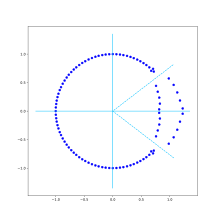Digital Signal Processing/FIR Filter Design
Filter design
[edit | edit source]The design procedure most frequently starts from the desired transfer function amplitude. The inverse Laplace transform provides the impulse response in the form of sampled values.
The length of the impulse response is also called the filter order.
Ideal lowpass filter
[edit | edit source]The ideal (brickwall or sinc filter) lowpass filter has an impulse response in the form of a sinc function:
This function is of infinite length. As such it can not be implemented in practice. Yet it can be approximated via truncation. The corresponding transfer function ripples on the sides of the cutoff frequency transition step. This is known as the Gibbs phenomenon.
Window design method
[edit | edit source]In order to smooth-out the transfer function ripples close to the cutoff frequency, one can replace the brickwall shape by a continuous function such as the Hamming, Hanning, Blackman and further shapes. These functions are also called window functions and are also used for smoothing a set of samples before processing it.
The following code illustrates the design of a Hamming window FIR:



#!/usr/bin/python3
import math
import numpy as np
import scipy.signal as sig
import matplotlib.pyplot as plt
# ------------------------------------------------------------------------------
# Constants
#
# filter
signal_bit_nb = 16
coefficient_bit_nb = 16
sampling_rate = 48E3
cutoff_frequency = 5E3
filter_order = 100
# time signal
input_signal_duration = 10E-3
frequency_1 = 1E3
amplitude_1 = 0.5
frequency_2 = 8E3
amplitude_2 = 0.25
# display
plot_time_signals = False
plot_transfer_function = False
plot_zeros = True
input_input_signal_color = 'blue'
filtered_input_signal_color = 'red'
transfer_function_amplitude_color = 'blue'
transfer_function_phase_color = 'red'
locus_axes_color = 'deepskyblue'
locus_zeroes_color = 'blue'
locus_cutoff_frequency_color = 'deepskyblue'
#-------------------------------------------------------------------------------
# Filter design
#
Nyquist_rate = sampling_rate / 2
sampling_period = 1/sampling_rate
coefficient_amplitude = 2**(coefficient_bit_nb-1)
FIR_coefficients = sig.firwin(filter_order, cutoff_frequency/Nyquist_rate)
FIR_coefficients = np.round(coefficient_amplitude * FIR_coefficients) \
/ coefficient_amplitude
transfer_function = sig.TransferFunction(
FIR_coefficients, [1],
dt=sampling_period
)
# ------------------------------------------------------------------------------
# Time filtering
#
sample_nb = round(input_signal_duration * sampling_rate)
# time signal
time = np.arange(sample_nb) / sampling_rate
# input signal
input_signal = amplitude_1 * np.sin(2*np.pi*frequency_1*time) \
+ amplitude_2*np.sin(2*np.pi*frequency_2*time)
input_signal = np.round(2**(signal_bit_nb-1) * input_signal)
# filtered signal
filtered_input_signal = sig.lfilter(FIR_coefficients, 1.0, input_signal)
# plot signals
if plot_time_signals :
x_ticks_range = np.arange(
0, (sample_nb+1)/sampling_rate, sample_nb/sampling_rate/10
)
y_ticks_range = np.arange(
-2**(signal_bit_nb-1), 2**(signal_bit_nb-1)+1, 2**(signal_bit_nb-4)
)
plt.figure("Time signals", figsize=(12, 9))
plt.subplot(2, 1, 1)
plt.title('input signal')
plt.step(time, input_signal, input_input_signal_color)
plt.xticks(x_ticks_range)
plt.yticks(y_ticks_range)
plt.grid()
plt.subplot(2, 1, 2)
plt.title('filtered signal')
plt.step(time, filtered_input_signal, filtered_input_signal_color)
plt.xticks(x_ticks_range)
plt.yticks(y_ticks_range)
plt.grid()
#-------------------------------------------------------------------------------
# Transfer function
#
# transfer function
(w, amplitude, phase) = transfer_function.bode(n=filter_order)
frequency = w / (2*np.pi)
# plot transfer function
if plot_transfer_function :
amplitude = np.clip(amplitude, -6*signal_bit_nb, 6)
log_range = np.arange(1, 10)
x_ticks_range = np.concatenate((1E2*log_range, 1E3*log_range, [2E4]))
amplitude_y_ticks_range = np.concatenate((
[-6*signal_bit_nb],
np.arange(-20*math.floor(6*signal_bit_nb/20), 1, 20)
))
phase_y_ticks_range = np.concatenate((
1E1*log_range, 1E2*log_range, 1E3*log_range
))
plt.figure("Transfer function", figsize=(12, 9))
plt.subplot(2, 1, 1)
plt.title('amplitude')
plt.semilogx(frequency, amplitude, transfer_function_amplitude_color)
plt.xticks(x_ticks_range)
plt.yticks(amplitude_y_ticks_range)
plt.grid()
plt.subplot(2, 1, 2)
plt.title('phase')
plt.loglog(frequency, phase, transfer_function_phase_color)
plt.xticks(x_ticks_range)
plt.yticks(phase_y_ticks_range)
plt.grid()
#-------------------------------------------------------------------------------
# Zeros
#
(zeroes, poles, gain) = sig.tf2zpk(FIR_coefficients, [1])
#print(zeroes)
# plot location of zeroes
if plot_zeros :
max_amplitude = 1.1 * max(abs(zeroes))
cutoff_angle = cutoff_frequency/sampling_rate*2*math.pi
cutoff_x = max_amplitude * math.cos(cutoff_angle)
cutoff_y = max_amplitude * math.sin(cutoff_angle)
plt.figure("Zeros", figsize=(9, 9))
plt.plot([-max_amplitude, max_amplitude], [0, 0], locus_axes_color)
plt.plot([0, 0], [-max_amplitude, max_amplitude], locus_axes_color)
plt.scatter(
np.real(zeroes), np.imag(zeroes),
marker='o', c=locus_zeroes_color)
plt.plot(
[cutoff_x, 0, cutoff_x], [-cutoff_y, 0, cutoff_y],
locus_cutoff_frequency_color, linestyle='dashed'
)
plt.axis('square')
#-------------------------------------------------------------------------------
# Show plots
#
plt.show()
Filter structure
[edit | edit source]A Finite Impulse Response (FIR) filter's output is given by the following sequence:
The following figure shows the direct implementation of the above formula, for a 4th order filter (N = 4):

With this structure, the filter coefficients are equal to the sample values of the impulse response.


